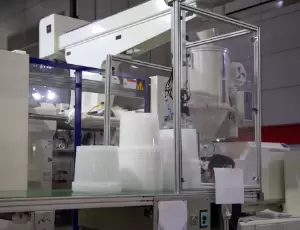Creating Motion & Calibration
Rockwell Automation Integration
Step 14
Checking Motion (ensure the proper safety checks are performed):
>Initial jog to confirm positive VelocityTrim extends the SHA. With the SHA_PositionControl block in place, also make sure the 2 rungs are below it which MOV the either the SHA_PositionControl’s CommandedPumpSpeed to the SHA_Axis.Velocity trim (for closed loop operation) when not in ManualMode, and the other block that moves the ManualPumpSpeed into the SHA_Axis.Velocity trim, for manual jogs. Set the ManualMode active, and then issue an MSO to the SHA_Axis. Now, if the ManualPumpSpeed is set to +0.5, it should extend the SHA. Set the ManualPumpSpeed to 0 to stop the jog (or use a pushbutton to Jog; etc.). If the positive ManualPumpSpeed retracts the SHA, then go to the SHA_Axis->Properties->Polarity and change the Motion Polarity to the other radio button and apply that.
Step 15
Input Card Setup and Calibration:
Pressure Feedback:
>Set up and calibrate the pressure feedback, if present. Typically, the SHA will have pressure feedback devices that are 0-10V for 0 to 3,000 psi. Note that the analog input should be configured for the fastest update rate. Depending on the analog input type, it may mean setting the digital filter to 0 ms; and/or setting the notch filter to the highest available selection (62,500 Hz, etc.). Set the RPI to 1.0 ms when possible. Set the RTS to 1 ms, where available; enable (check) the Synchronize Module Inputs when available.
If the analog input needs to be scaled in ladder logic, then put that logic in the SHA_Routine before/above the SHA_PositionControl block; or, put it in its own routine in the SHA_MotionTask_Program and run it before the SHA_PositionControl runs.
Loadcell Feedback:
If a LoadCell is being used, then its calibrated value is provided to the SHA_PositionControl as the Extend or Retract pressure feedback, and the SHA_Config.ExtendForceGain and RetractForceGain should be set to 1.
The SHA_PositionControl tag (SHA_PositionController in the sample projects) also has a ForceLimitingDeadband member, which is typically set in the range of 5 to 15, depending on the Force output of the SHA.
>Verify the SHA_Config.ForceExtendGain and ForceRetractGain values. If a LoadCell is used, these must be 1. If a pressure sensor is used, then these members will need the ForceGain values provided by Kyntronics, which are set based on the physical geometry of the SHA Rod and Cylinder. Contact Kyntronics or sales@kyntronics.com as needed, to obtain these values (include the SHA Part Number and / or the Sales Order number).
Position Feedback:
>Set up and calibrate the position feedback. Some sensors are absolute and will only need minimal setup. For the standard, externally mounted Temposonic analog sensor, it is possible to set it up based on 0-10V feedback and with the length based on model # set at the 10V side, and converted to proper units, as needed. For example, the Temposonic model EL00175MD341V01 is 0-10v and 175mm (which is 6.88976”), so the 10V value can be set to 175.0mm or 6.88976”. This works, but it means the lowest position will be a value based on the mount position of the sensor. It is also possible to measure and adjust the analog calibration and use two points to set up a custom calibration where the 0.0 position is with the SHA rod slightly extended (~0.2 inch) and a fully retracted position is then slightly negative. With these two points entered, the analog module will interpolate values from that. This custom calibration is detailed below.
It is recommended NOT to fully retract the SHA as its home/starting position, as this can spike the internal pressure of the actuator. Instead, use a home/start position with the actuator extended by 0.2” to 0.25” from the full retract position.
An alternate method often used, is to calibrate the position feedback such that the 0.0” position occurs when the actuator is at that slightly extended from the fully retracted position. For accurate calibration using this method, a precision caliper can be used.
If the analog input is set to volts initially, for the calibration, then jog the SHA to that slightly extended position, or extended far enough to use a caliper for an accurate reading, and write down the caliper reading and the displayed voltage:
For example:
caliper reading: 0.45” and voltage: 0.99
Then jog the SHA to a more extended position, within the range of your calipers; say to 4 or 5” on this SHA, and take a reading there:
5.45” and voltage: 8.3
Now, shift these values by 0.25” so the zero point gets moved up, and the fully retracted position will show up as -0.25”.
Take the 2 values above, and shift both by the 0.25” offset, so the values entered in the channel configuration will be:
0.45” – 0.25” = 0.2 inches at the 0.99 voltage
5.45” – 0.25” = 5.2” at the 8.3 volt reading





















